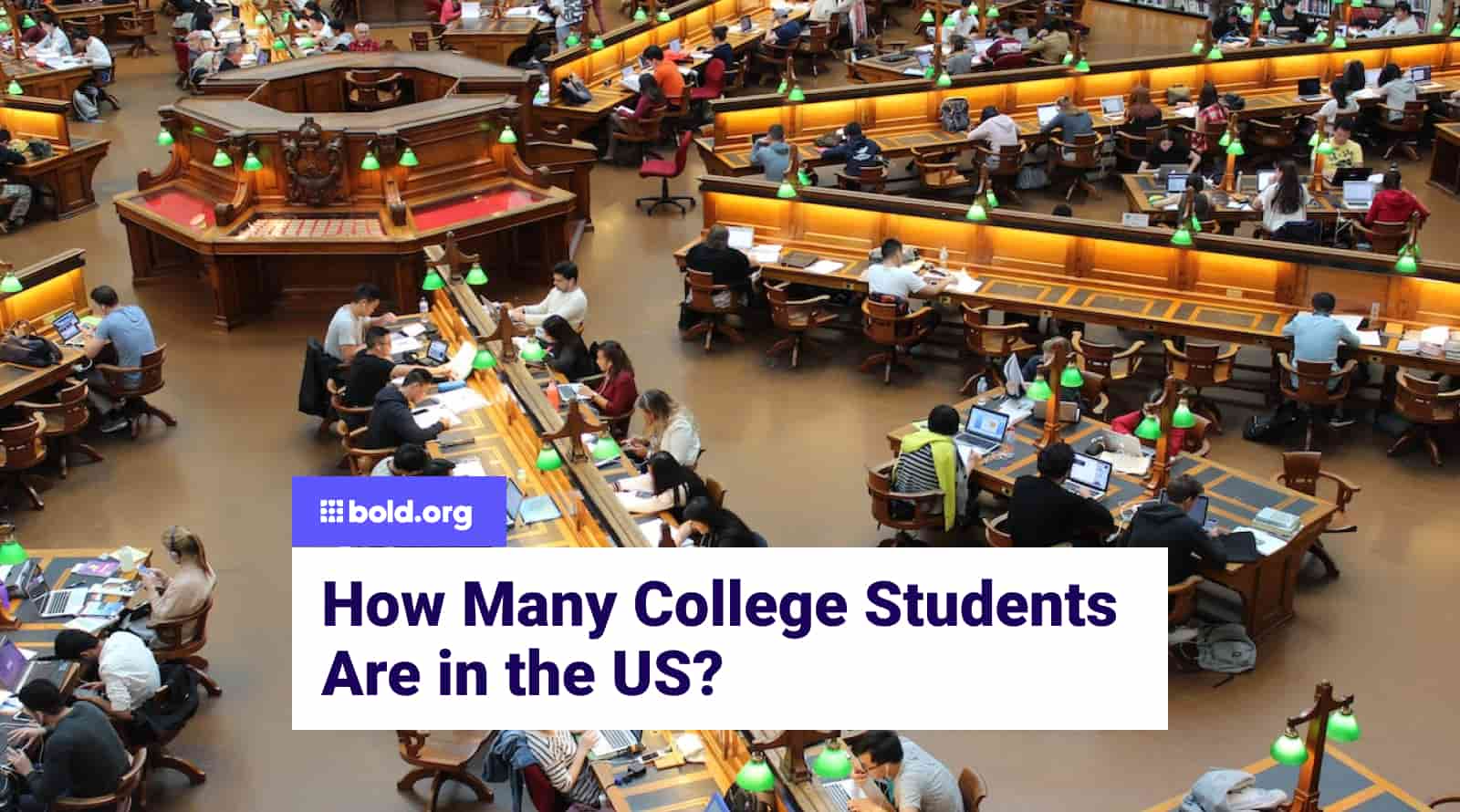Access thousands of exclusive scholarships
for free
Education stands as an enduring cornerstone of society, serving as a conduit for personal growth, skill development, and the attainment of knowledge. In the ever-evolving landscape of the United States, the higher education sector plays a pivotal role in shaping the nation's future.
This multifaceted landscape encompasses a diverse array of institutions, from accessible community colleges offering foundational education to prestigious universities at the forefront of research and innovation. These educational institutions host a tapestry of individuals, each with their own aspirations and goals, spanning both undergraduate and graduate programs.
Within these halls of learning, students passionately engage in intellectual pursuits, preparing themselves for the challenges and opportunities that lie ahead in their professional and personal lives. Amidst this vibrant educational environment, a crucial question arises: how many college students are there in the United States? This question delves into the heart of a nation's commitment to learning and the impact it has on the individuals who make up this vast, dynamic, and ever-changing educational landscape.
In this article, we delve into the dynamic world of college education, exploring recent statistics and trends in college enrollment. The data in this blog is accurate through the 2021-2022 school year, with information provided by the National Center for Education Statistics (NCES). By understanding the current state of college enrollment, we can gain valuable insights into the nation's higher education institutions and the numerous opportunities they can provide.

Total College Enrollment
A diverse population of approximately 19.0 million students pursued higher education across a range of educational institutions, including both traditional colleges and universities and non-degree-granting establishments, in fall 2021. The high college enrollment rates reflect the significance and breadth of the educational landscape, as well as the opportunities available to those eager to pursue postsecondary education.
College Enrollment by Level
Approximately 15.8 million students were enrolled in undergraduate programs, while an additional 3.2 million pursued graduate studies.
This stark contrast in numbers highlights the prevalence of undergraduate education as the primary gateway for students into higher learning, providing a foundation upon which a smaller but significant proportion continue their academic journey at the graduate level. These figures underscore the dual pillars of the higher education system, with undergraduate programs catering to a broader demographic and graduate programs serving as specialized avenues for advanced learning and research.
Together, these numbers also reflect the multifaceted nature of higher education, providing opportunities for a broad spectrum of students to explore, specialize, and excel in their respective areas of interest and expertise. It's a testament to the versatility and richness of educational pathways available to those seeking to expand their horizons and contribute to their chosen fields.
Are you a first-generation student looking for scholarships? Check out these first-generation scholarships today!
Get Matched to Thousands of Scholarships
Create your Bold.org profile to access thousands of exclusive scholarships, available only on Bold.org.
Create Free ProfileCollege Enrollment by Institution Type
About 13.7 million students attended public institutions, while 5.4 million students attended private institutions.
These statistics illuminate the diversity of options available to students. Public universities and colleges draw the majority, underscoring accessibility and affordability. Private institutions cater to a substantial, yet smaller, portion of the student body, emphasizing distinctive educational experiences, specialized programs, and smaller class sizes. This division between public and private institutions represents the multifaceted landscape of higher education, offering students a range of choices tailored to their individual preferences and aspirations.
Enrollment by Program Length
Among the 19.0 million students who pursued postsecondary education, 0.3 million students enrolled in less-than-2-year institutions, seeking short-term and specialized training. A significant proportion of 4.8 million students chose 2-year institutions, often community colleges, for a more flexible and accessible education. Meanwhile, a substantial 14.0 million students embarked on longer and more comprehensive academic journeys at 4-year institutions, such as universities and colleges, aiming to attain undergraduate and, in many cases, graduate degrees.
This segmentation of educational choices demonstrates the flexibility and variety available to students as they carve out their academic paths in accordance with their unique aspirations and needs.

College Enrollment by Gender
Within the student population, 11.1 million students were female, and 7.9 million were male. This breakdown in college enrollment has important implications for academia, workforce development, and societal progress. The substantial representation of female students underscores the progress made in promoting equality in education as women continue to make strides in pursuing higher education and challenging historical imbalances.
Conversely, the presence of 7.9 million male students reminds us that gender equity is a multifaceted issue. It's important to ensure that male students receive the necessary support and resources to thrive in educational settings and have equal access to opportunities as well. These data emphasize the importance of fostering an inclusive and supportive learning environment for all. These data also suggest that other factors related to gender are not thoroughly researched or understood.
If you're a single mom in college, check out these single parent scholarships for moms!

College Enrollment by Race and Ethnicity
The diversity of the student population in this data reveals a multifaceted educational landscape. Among the approximately 19.0 million students, 9.2 million identified as white, while 3.6 million were of (non-white) Hispanic origin, 2.3 million were black, and 1.3 million were of Asian descent.
Additionally, 0.7 million students had multi-racial backgrounds, 0.1 million were American Indian/Alaska Native, and 46,600 students hailed from Native Hawaiian or other Pacific Islander backgrounds. Furthermore, 0.9 million students were U.S. nonresidents and, thus, weren't categorized by race or ethnicity, while another 0.9 million students had unrecorded race or ethnicity data.
Recognizing these students come from a wide range of backgrounds and identities showcases how diverse the student population is in the US. These statistics underscore the richness and complexity of the student body, showcasing the diversity of racial and ethnic identities while also acknowledging gaps in data collection and highlighting the need for more comprehensive reporting.

Financial Aid Statistics
A significant portion of students – that is, 72 percent – received some type of financial aid to facilitate their educational pursuits, underscoring the importance of financial assistance in the higher education landscape.
Among these students, 55 percent received money from federal student aid programs, demonstrating the widespread reliance on government-funded initiatives to access education. About 17 percent received exclusively private financial aid.
Furthermore, 34 percent of these students were recipients of subsidized or unsubsidized federal Direct Loans, emphasizing the role of these loans in providing critical financial resources for many college students' academic journeys.
These statistics illuminate the pervasive need for financial aid in higher education and the pivotal role of federal programs in enabling students to overcome financial barriers to achieve their educational goals.
Students can apply for more financial aid right here on Bold.org, where thousands of exclusive scholarships are updated daily. The best thing about scholarships is that they don't have to be repaid (unlike loans)!
Online vs. In-Person Enrollment
59 percent of postsecondary students, or about 11.2 million students, were enrolled in any distance/online education course.
50 percent of those 11.2 million students or 30 percent of total enrollment (about 5.7 million students) were enrolled exclusively in distance/online education courses.
These statistics underscore the growing prominence of online education, with a considerable portion of the student body fully embracing this mode of learning. This growth in the popularity of online courses highlights the adaptability and accessibility of digital platforms in higher education.
Part-Time vs. Full-Time Enrollment
A diverse population of 11.6 million individuals devoted themselves to full-time studies, reflecting a dedicated and immersive approach to their academic endeavors. For such students, their educational journey is typically their primary commitment, allowing for a deep and comprehensive exploration of their chosen fields of study.
7.4 million students instead opted for part-time enrollment, choosing a more flexible and multifaceted approach to their education. These part-time students often balance their studies with other responsibilities, such as work or family commitments; a part-time schedule allows them to tailor their educational experience to better suit their individual life circumstances.
This juxtaposition of full-time and part-time attendance exemplifies the diverse ways in which students engage with the pursuit of knowledge and skill development in higher education, catering to a wide range of academic aspirations and life situations.
Check out our Scholarship Blog to learn more about part-time and full-time college enrollment!

Frequently Asked Questions About the Number of College Students in the US
What percent of people go to college in the US?
As of October 2022, about 62 percent of high school graduates enrolled in college or university. This statistic showcases the enduring allure of higher education, with a substantial majority of recent high school graduates recognizing the value of advancing their knowledge and skills in a structured, post-secondary setting.
Is it difficult to get into college in the US?
The level of difficulty varies across colleges, so always research your particular colleges of interest for better information. There is a higher education option out there for everyone, from trade schools to four-year colleges and universities.
How can I get into a good college?
Planning early, attending class, studying, and meeting with a school guidance counselor or college coach are all helpful ways to get into good colleges. Keep your GPA up, join extracurriculars, and do your best on standardized tests. You've got this!

